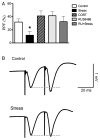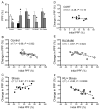Acute stress, but not corticosterone, disrupts short- and long-term synaptic plasticity in rat dorsal subiculum via glucocorticoid receptor activation
- PMID: 22918985
- PMCID: PMC4457523
- DOI: 10.1093/cercor/bhs247
Acute stress, but not corticosterone, disrupts short- and long-term synaptic plasticity in rat dorsal subiculum via glucocorticoid receptor activation
Abstract
The subiculum (SUB) serves as the major output structure of the hippocampus; therefore, exploring synaptic plasticity within this region is of great importance for understanding the dynamics of hippocampal circuitry and hippocampal-cortical interactions. Previous research has shown exposure to acute stress dramatically alters synaptic plasticity within the hippocampus proper. Using in vivo electrophysiological recordings in urethane-anesthetized adult male Sprague-Dawley rats, we tested the effects of either acute restraint stress (30 min) or corticosterone (CORT) injections (3 mg/kg; s.c.) on short- and long-term forms of synaptic plasticity in the Cornu Ammonis 1-SUB pathway. Paired-pulse facilitation and two forms of long-term plasticity (long-term potentiation and late-developing potentiation) were significantly reduced after exposure to acute stress but not CORT treatment. Measurements of plasma CORT confirmed similar levels of circulating hormone in animals exposed to either acute stress or CORT treatment. The disruptive effects of acute stress on both short- and long-term forms of synaptic plasticity are mediated by glucocorticoid receptor (GR) activation as these disruptions were blocked by pre-treatment with the selective GR antagonist RU38486 (10 mg/kg; s.c.). The present results highlight the susceptibility of subicular plasticity to acute stress and provide evidence that GR activation is necessary but not sufficient for mediating these alterations.
Keywords: hippocampus; in vivo electrophysiology; late-developing potentiation; long-term potentiation; paired-pulse facilitation.
Conflict of interest statement
Figures





Similar articles
-
Acute stress and hippocampal output: exploring dorsal CA1 and subicular synaptic plasticity simultaneously in anesthetized rats.Physiol Rep. 2013 Jul;1(2):e00035. doi: 10.1002/phy2.35. Epub 2013 Jul 21. Physiol Rep. 2013. PMID: 24303119 Free PMC article.
-
Acute stress disrupts paired pulse facilitation and long-term potentiation in rat dorsal hippocampus through activation of glucocorticoid receptors.Hippocampus. 2010 Dec;20(12):1327-31. doi: 10.1002/hipo.20738. Hippocampus. 2010. PMID: 20043285
-
Glucocorticoid receptor activation selectively hampers N-methyl-D-aspartate receptor dependent hippocampal synaptic plasticity in vitro.Neuroscience. 2005;135(2):403-11. doi: 10.1016/j.neuroscience.2005.05.039. Neuroscience. 2005. PMID: 16125856
-
Glucocorticoid- and long-term stress-induced aberrant synaptic plasticity are mediated by activation of the glucocorticoid receptor.Arch Pharm Res. 2015 Jun;38(6):1204-12. doi: 10.1007/s12272-015-0548-0. Epub 2015 Jan 7. Arch Pharm Res. 2015. PMID: 25564339
-
Synaptic plasticity in the hippocampal area CA1-subiculum projection: implications for theories of memory.Hippocampus. 2000;10(4):447-56. doi: 10.1002/1098-1063(2000)10:4<447::AID-HIPO11>3.0.CO;2-2. Hippocampus. 2000. PMID: 10985284 Review.
Cited by
-
Acute stress causes sex-dependent changes to ventral subiculum synapses, circuitry, and anxiety-like behavior.bioRxiv [Preprint]. 2024 Aug 3:2024.08.02.606264. doi: 10.1101/2024.08.02.606264. bioRxiv. 2024. Update in: Nat Commun. 2025 Jul 1;16(1):5604. doi: 10.1038/s41467-025-60512-y. PMID: 39131353 Free PMC article. Updated. Preprint.
-
Additive gene-environment effects on hippocampal structure in healthy humans.J Neurosci. 2014 Jul 23;34(30):9917-26. doi: 10.1523/JNEUROSCI.3113-13.2014. J Neurosci. 2014. PMID: 25057194 Free PMC article.
-
Experience and the ever-changing brain: what the transcriptome can reveal.Bioessays. 2014 Nov;36(11):1072-81. doi: 10.1002/bies.201400095. Epub 2014 Sep 11. Bioessays. 2014. PMID: 25213333 Free PMC article. Review.
-
Transcriptional Profiling of Rat Prefrontal Cortex after Acute Inescapable Footshock Stress.Genes (Basel). 2023 Mar 17;14(3):740. doi: 10.3390/genes14030740. Genes (Basel). 2023. PMID: 36981011 Free PMC article.
-
Stress facilitates late reversal learning using a touchscreen-based visual discrimination procedure in male Long Evans rats.Behav Brain Res. 2015 Feb 1;278:21-8. doi: 10.1016/j.bbr.2014.09.027. Epub 2014 Sep 22. Behav Brain Res. 2015. PMID: 25251839 Free PMC article.
References
-
- Andersen P, Morris R, Bliss T, Amaral D, O’Keefe J. The Hippocampus Book. New York: Oxford University Press US; 2006.
-
- Anderson M, Commins S, O’Mara SM. The effects of low frequency and two-pulse stimulation protocols on synaptic transmission in the CA1–subiculum pathway in the anaesthetized rat. Neurosci Lett. 2000;279:181–184. - PubMed
-
- Behr J, Wozny C, Fidzinski P, Schmitz D. Synaptic plasticity in the subiculum. Prog Neurobiol. 2009;89:334–342. - PubMed
-
- Boeijinga PH, Boddeke HWGM. Activation of 5-HT1B receptors suppresses low but not high frequency synaptic transmission in the rat subicular cortex in vitro. Brain Res. 1996;721:59–65. - PubMed
-
- Cazakoff BN, Howland JG. Acute stress disrupts paired pulse facilitation and long-term potentiation in rat dorsal hippocampus through activation of glucocorticoid receptors. Hippocampus. 2010;20:1327–1331. - PubMed
Publication types
MeSH terms
Substances
Grants and funding
LinkOut - more resources
Full Text Sources
Molecular Biology Databases

